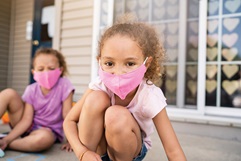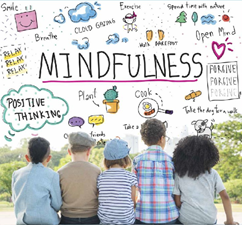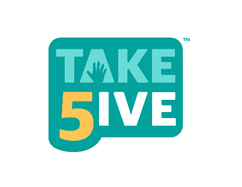In this section
Community partners and professionals
- Child abuse prevention
- Child Advocacy and Protection Services (CAPS)
- Child Welfare Services
- Memberships and accreditation
- Child well-being: Strong Families, Thriving Children
- Resources for schools
- Nutrition ages 2 to 4
- Nutrition ages 5 to 12
- Nutrition 13 and up
- Physical activity ages 2 to 4
- Physical activity ages 5 to 12
- Physical activity 13 and up
- Healthy minds ages 2 to 4
- Healthy minds ages 5 to 12
- Healthy minds 13 and up
Healthy minds-ages 5 to 12
Use these activities with your family to learn about mental and emotional health, practice being mindful, learn ways to be more focused and engaged, and check out some useful tips about sleep.
Mental and emotional health
What is mental and emotional health?
 Mental health and emotional health are often used interchangeably, but they actually mean different things.
Mental health and emotional health are often used interchangeably, but they actually mean different things.
- Mental health includes emotional, psychological and social well-being.
- Emotional health is part of mental health, and includes thoughts, feelings and emotional expressions or behaviors.
- What is mental health | En Español
Ways to help when your child is stressed
Getting your kids to talk about stress can be hard, but there are ways you can help them if they're feeling overwhelmed.
- If you notice something is bothering your child, talk to them about how they're feeling. Try to be open and understanding with them, and allow your child to express themselves and be heard. Helping them to put a name to how they are feeling can be useful.
- Once your child opens up about something that's causing them stress, it's really important to listen to them in a calm and caring way. Let them take their time, and try to ask open-ended follow-up questions to avoid yes or no answers. For example, asking them, "What happened next?" or, "How did that make you feel?" can allow them to keep sharing.
- Problem solving is an important skill for children to develop, so try to help them solve the problem on their own instead of solving it for them.
- If you notice certain situations or activities are causing your child to become more stressed, try to limit those, if possible.
Check out this article from KidsHealth to learn more about childhood stress.
Reducing mental health stigmas
 Mental health stigmas are negative attitudes and beliefs about people with mental illness that often come from a lack of understanding. Stigmas can get in the way of seeking treatment for a mental illness, and can lead to problems at school or work, bullying and self-doubt.
Mental health stigmas are negative attitudes and beliefs about people with mental illness that often come from a lack of understanding. Stigmas can get in the way of seeking treatment for a mental illness, and can lead to problems at school or work, bullying and self-doubt.
Here are some ways to help reduce stigmas:
- Talk openly about mental health to make it more relatable and understandable for others.
- Educate yourself about mental health, and when possible, try to help educate others.
- Use respectful language and put the person before the disorder. This can help to see the person, not the condition.
- Avoid unkind labels that contribute to social stigma.
- Be supportive if you think someone is struggling with their mental health.
Anxiety
It's important to know that worrying can be part of anxiety, but anxiety isn't always centered on worrying. Anxiety in children isn't always a bad thing, but you may want to take steps to help them manage their anxiety if it starts to interfere with daily activities or impacts their decisions in a negative way.
Anxiety symptoms can include:
- Rapid breathing
- Sweating
- Nausea
- Tense muscles
- A thumping or rapid heart rate
- Feelings of dread
There are a number of things that you can do to help your child cope if they are experiencing anxiety symptoms:
- Talk about anxiety with them. If a certain situation is making them feel anxious, talk through how they can manage the situation and what they can do to reduce their feelings of anxiety. Having a plan can help ease anxiety symptoms for some children.
- Model managing anxiety in a healthy way. How you cope with anxiety has a large impact on how your child may cope.
- Try to not avoid things that make a child anxious. This can help in the short term, but over the long term, it can reinforce anxiety and can make things worse. Be encouraging and listen, and let them know that you're confident they will get through the situation.
Learn how to manage anxiety.
Depression
Rates of depression in children have been on the rise over the past few years, and noticing signs of depression early can have an impact on diagnosis and treatment.
Signs of depression can look different in children than it does in adults and can include:
- Decreased or loss of interest in typical activities
- Becoming socially withdrawn
- Changes in sleep patterns
- Focusing on problems
- Appetite or weight changes
- Aggression or irritability
- Feelings of hopelessness
Video: Ask the experts | Depression in kids and how to help
Visit this KidsHealth webpage to learn more about childhood depression.
Talking to your kids about feelings
Children may not have the right words to describe what they are feeling as they grow and experience new things, so try and pay attention to cues, such as changes in body language or behavior. Finding out how your child feels- and why- can help lead to managing and expressing emotions in a healthy way.
Try spending some time with your child each day to talk about what happened at school. Let your child know they can talk to you about different situations and be sure to let your child know if they are doing something well. Make sure that your child feels like they can express their emotions, and try to listen without judgment.
Video: Conversation starters | Talking to your kids about feelings
Mindfulness
What is mindfulness?

Mindfulness is a research-based tool that starts with purposefully bringing focus to thoughts, emotions, physical feelings and environment. It allows kids to learn how to pause, which can be very beneficial for them both in school and at home.
Using mindfulness can help with increasing self-awareness, self-regulation and impulse control. Improved focus and attention, decreased stress and anxiety, increased feelings of kindness and increased ability to manage emotions are common results of mindfulness practice in both kids and adults.
Mindfulness activities you can do at home
The mindful jar
This activity can teach children about how strong emotions can take hold, and how to find peace when these strong emotions come up. Watch the mindful jar video below to practice being mindful. | En Español
The chime listening exercise
This exercise is not only fun and gets kids excited about sharing their experiences with others, but really helps them connect to the present moment and the sensitivity of their perceptions.
Ring a chime or bell and ask kids to listen closely to the vibration of the ringing sound. Ask them to remain silent and raise their hands when they no longer hear the sound of the bell. Then ask them to remain silent for one minute and pay close attention to the other sounds they hear once the ringing has stopped. Afterward, ask them to tell you every sound they noticed during that minute.
The Hoberman sphere
Using a Hoberman sphere, or breathing ball, can help teach kids mindful breathing. Watch the Hoberman sphere video below to practice mindful breathing.
Take 5ive
These Take 5ive™ videos offer three types of guided exercises designed to develop focus and attention skills, cultivate everyday kindness strategies, compassion and gratitude and reset and attune the mind-body connection through movement. The videos feature calming natures scenes with voiced instructions throughout the practice or animations that are movement based.

- Learn more about how to grow healthy minds at home.
Screen time
What is screen time?
 Screen time includes watching TV, using a cell phone or tablet, working on a computer, or playing video games. Because screen time is a sedentary activity, it can have a negative impact on overall health.
Screen time includes watching TV, using a cell phone or tablet, working on a computer, or playing video games. Because screen time is a sedentary activity, it can have a negative impact on overall health.
Children who watch too much television have a higher risk of childhood obesity, have less energy and may have a harder time in school. They are more prone to exhibit aggressive behavior due to their tendency to copy what they see.
Screen time guidelines
For children 2 to 5 years old, try to limit screen time unrelated to school to 1 hour per day. For kids 6 and older, parents should monitor the amount of screen time kids get and from what types of devices. As a general rule, 2 hours should be the daily limit.
Screen time, especially in the hours before bedtime, is associated with poor quality of sleep for everyone. Turn off devices 30 minutes before bed to help improve sleep quality. The bright lights increase alertness and could impact melatonin, a hormone that is important for the sleep-wake cycle.
Video: Conversation starters | Reducing screen time
Parents and adults can model good behavior by reading books or getting outside to be active instead of watching TV. Encouraging healthy behaviors and limiting unhealthy ones will help kids build healthy habits.
Set boundaries and times that kids can have screen time and try finding other activities for children, such as board games, arts and crafts or sports to take the place of screen time.
Be on the lookout for behavioral changes. Kids can become irritable, aggressive, selfish, or impatient after too much screen time.
Cut down on having screens during mealtimes and car rides. About 64% of people have their TV on during mealtimes, so try turning off the TV and talk to your kids about their day.
Avoid putting TVs in bedrooms. This will reduce screen time and can help improve the quality of sleep that kids, and their parents, get!
Sleep
Sleep recommendations and importance
It is recommended that school-aged kids between 6 and 13 years old get between 9 and 11 hours of sleep per night. Some kids require a little less or a little more, but 9-11 hours is appropriate for most kids.
Kids need sleep to support their mental and physical development. Not getting enough sleep can cause kids to feel tired or cranky and to have difficulty thinking clearly or following directions. Growth and immune system health can also be impacted by a lack of sleep.
How to help kids get enough sleep
Try to have them go to bed at the same time every night to establish a consistent sleep schedule. Follow a calming routine each night, like taking a warm bath or reading a few pages of a book. A bedtime routine can help with adjustment to a new schedule.
Avoid foods and drinks that contain caffeine, such as some sodas and teas. Avoid scary TV shows or movies close to bedtime. Don't allow exercise just before bed. However, exercise earlier in the day does help a person sleep better.
Use beds just for sleeping instead of things like doing homework, reading, playing games and talking on the phone. This will help train their bodies to associate their bed with sleep.
Children's Wisconsin is committed to addressing the mental and behavioral health crisis facing our children.
Children's Shine Through awareness initiative brings to life the important work Children's is doing to detect needs sooner, reduce stigma and improve access to care for kids with mental and behavioral health needs. Learn more about Shine Through.
Suicide resources
National Suicide Prevention Lifeline (800) 273-8225
